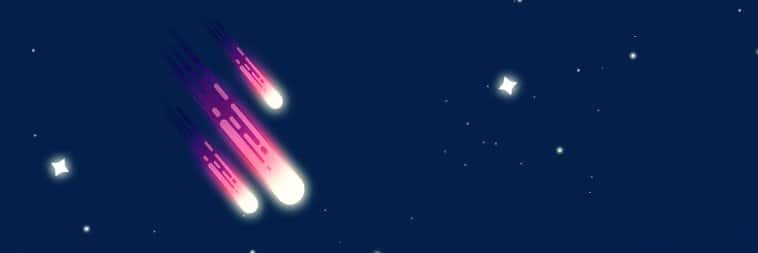Astronomical event: Lyrid Meteor Shower 2021

Discover the Lyrid meteor shower 2021. Learn what a meteor shower is, how the Lyrid meteor shower originated and how to best view the meteor shower in 2021.
What is a meteor shower?
A meteor shower occurs when our planet, the Earth, goes through debris left behind by comets and asteroids. When you see a shooting star from the Earth, it is most likely a piece of debris colliding with our atmosphere. Nothing to worry about though, since the debris burns up at an altitude of around 70 to 100 km. This collision does cause beautiful shooting stars, which is also called a meteor shower!
As the Earth’s orbit passes through space, recurring streams of debris pass by. These so-called dense streams are caused by comets or asteroids that have left behind a lot of material in space.
Each year, the debris particles travel in the same direction while crossing the Earth’s orbit. This causes the particles to strike the Earth in the same direction and at the same speed, causing annual meteor showers.
Lyrid meteor shower
One of these annual meteor showers is the Lyrid meteor shower, also known as the April Lyrids. As can be expected, the name resonated from the meteor shower radiating from the constellation Lyra, which is close to the star Vega. The Lyrid meteor shower is among the oldest known meteor showers. It was first recorded 2700 years ago. The ancient Chinese have observed the Lyrid meteors as early as the year 687 B.C.!
The Lyrid meteor shower is caused by the debris and particles left behind by comet C/1861 G1 (Thatcher). Every year in April our Earth’s orbit crosses the path of this comet. We have never laid eyes on this comet, since its orbit around the Sun takes about 415 years. The last time that the comet Thatcher visited the Earth was in 1861. Unfortunately, taking photographs was not yet possible back then. Perhaps we will be able to photograph the comet when it returns in the year 2276.
Viewing the meteor shower
Curious to see the meteor shower this April? The Lyrid meteor shower 2021 will be active from April the 16th to April the 25th. The most meteors can be seen around the 22nd of April on a Thursday.
The constellation Lyra, and the Lyrid meteor shower are best visible from the Northern Hemisphere. You are also able to view the meteor shower from the Southern Hemisphere though! Make sure that you locate the star Vega, in the constellation Lyra, which rises in the hours before dawn. It will be lower in the sky than for the Northern Hemisphere.
You can view the meteor shower whenever the constellation Lyra is located above the horizon. To see the most meteors, the best place to look is not directly at the radiant itself, but at any dark patch of sky which is around 30–40° away from it. It is at around this distance from the radiant that the most meteors will be seen
The meteor shower will produce the best displays shortly before dawn, since the constellation Lyra is at its highest. The Moon however is located in the constellation Leo, and will only be 4 days away from full phase at the shower’s peak. Therefore, the light pollution from the Moon can present significant interference throughout the night.
⭐ Tip! To prevent any other light pollution, make sure to view the meteor shower from the country, away from the city lights.
Discover the astronomical event of April 2021!
Are you ready to see the Lyrid meteor shower 2021 this April? The Lyrid meteor shower is caused by the debris and particles left behind by the comet Thatcher and has created beautiful views for us here on Earth! You can view the meteor shower from April 16th to April 25th. The most meteors will be visible around the 22nd of April on a Thursday. Ready for the meteor shower? Make sure to know where the constellation from which the meteors radiate is located!
